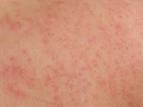Baby Skin Rash Pictures Biography
Source(google.com.pk)Rashes are rarely urgent and almost never require an urgent page to your doctor. In fact, there is basically only one rash that requires immediate medical evaluation – this is a rash called petechiae or purpura, which involves ruptured blood vessels under the skin. We will discuss later how to recognize this rash. Virtually all other rashes can wait until you can call your doctor’s office to schedule an appointment. Diaper Rashes are discussed in a separate section. Here are the most common childhood rashes. Read through them to see if any seem to match your child’s rash. If not, then the following section may help you identify the rash. None of these 5 rashes warrants an urgent page to your doctor, unless you feel your child is unusually ill.
Hives – these are welts. They can appear suddenly out of nowhere, and can spread rapidly. They are most common on the trunk, but can also be on the extremities, and rarely on the face. A very distinct characteristic of hives is that each welt will often come and go over a period of 10 to 15 minutes or as long as a few hours. You will see some welts on the tummy, and then look again an hour later and find them gone, only to see new ones on the back. The welts can be small or very large, round or irregularly shaped, single or clustered together and over-lapping. They usually itch, but not always. Hives are caused by the body having an allergic reaction to a variety of things including foods, medications, external irritants such as soap, detergent, clothing material, or grass. Children can also get hives during a normal illness such as a cold or fever. Because this is an allergic reaction, you need to observe your child for other signs of a severe allergic reaction such as throat tightness, wheezing, breathing difficulty, or persistent vomiting. Go to the ER if these happen. Click here for a full discussion click on Hives. The standard treatment for hives is Benadryl.
Eczema – Eczema is a condition caused by two factors: first, a genetic tendency toward dry, irritated skin; and second, skin allergies to a variety of irritants and foods. Eczema has two different appearances. When this rash is mild it looks like flat, dry, white patches. During flare-ups it appears as red, irritated, raised patches. This rash characteristically occurs on the inner elbows and behind the knees in infants and young children. In older children it usually affects the front of the knees and outside of elbows. In can also appear on the trunk, face, hands and feet. Your child can have as little as one patch, or dozens. Eczema can either be a short-lived temporary reaction to something in your child’s environment, or it can be a chronic condition lasting for years. The diagnosis and treatment of eczema is extremely involved. Click here for a full discussion on Eczema. The standard treatment is hydrocortisone cream 1%, over the counter.
Viral illness – the most common rash suddenly appearing on your child is rash due to a variety of viruses. Some viruses can be easily identified, including chicken pox, fifth disease, and roseola. Most viruses, however, do not cause their own specific type of rash as chicken pox does. These generic viral rashes can have many different appearances, such as lacy or pimply, raised or flat, bumps, spots, or blotches, and they often (but not always) start on the trunk, and then spread to the extremities.The most important thing to understand here is that if your child has a fever or is not feeling well, and breaks out in one of these generic rashes, then it is probably a harmless virus and nothing to worry about.Here is a brief description of some identifiable viral rashes:Chicken pox – this starts off with a few red spots or bumps (often mistaken for insect bites). Fever is common. The next day many more bumps will appear, and the first bumps will have turned into blisters. On the third day, new bumps will appear, and the second-day bumps will start to blister. On day 4 the original blisters will start to crust over. Usually by day 5, no new bumps will appear, and more blisters will crust over. By day 7, most or all of the blisters will be crusted over. The fever can last for 5 days. Once the fever is gone and all the blisters are crusted over, your child is no longer contagious. If this sounds like what your child has, click on chicken pox for a complete discussion. Very important note – it is nearly impossible to diagnose chicken pox on day 1, and still difficult to know for certain on day 2. Therefore, do not bring your child into the doctor on day 1 or 2 and expect a definite diagnosis. If you think its chicken pox, then quarantine your child until day 3. If the spots have progressed as described above, then you probably don’t even need a doctor to confirm it. Dr. Sears advises: When you first notice some spots draw a circle around a few of them. If they change into blisters within 24 hours, consider it chicken pox.
Fifth disease (or Slapped Cheek disease) – this is a very common virus. It starts out causing bright red cheeks (it looks like your child has been slapped), and sometimes a fever. Then a generic lacy or pimply rash spreads from the trunk to the extremities. There may also be a runny nose and cough. If this sounds like what your child has, click on it for a detailed discussion.
Roseola – this is one of the most common causes of fever and rash in infants and young children. It starts out with three days of moderate to high fevers, with no other symptoms. Just when you start to get worried, the fever breaks on day four and your infant develops the rash yet acts almost entirely well. The rash consists of red spots and bumps starting on the upper back and neck, spreading down the trunk and into the extremities. It sometimes has a lacy appearance. If this sounds like what your child has, then click on it for more info.
Heat rash – this appears as tiny red pimples, bumps, or spots. It usually appears on the back of the neck or lower back, but can involve the entire trunk. It occurs due to a mix of sweat, heat and clothing. Treat this by cooling your baby off, airing out the area, or applying a cool washcloth.
Contact rash – there are two types of contact rash. The first type appears as red, raised bumps or patches, and can have a slight crusty surface. It is extremely itchy. They can also run in a line on the skin from the irritant being scratched along the skin. This is often initially confined to one or two small areas on the body, but then may spread over the next few days. It is caused by contact with an irritant such as poison ivy, other plants, cleaners or other chemicals.Notice the red raised patch with crusty drainage in the middle. Notice the straight lines of rash due to scratching and spreading the poison. This type of rash is treated with over-the-counter hydrocortisone 1%, calamine lotion, and benadryl liquid for severe itching. Stronger prescription creams can be used if needed. You can prevent this type of rash by applying a lotion to the skin prior to adventuring, and then rinsing the skin after returning home, with a special lotion available at sporting goods stores. One such brand is Tech-Nu, but any brand should work. The second type of contact rash is more generalized throughout the body, very similar to the generic viral rashes discussed above. It occurs as fine, red pimples or small spots. It can be caused by a huge variety of irritants such as new clothes, soaps, shampoos, bubble baths, detergents or fabric softeners, suntan or other lotions, bed sheets, grass, swimming pools or anything else that comes into contact with your child’s skin. The treatment is to figure out the cause, and use hydrocortisone as above if needed.
Baby Skin Rash Pictures Skin Rashes In Children On Face In Adults On Hands On Arms That Itch In Kids On Dogs On Chest On Neck

Baby Skin Rash Pictures Skin Rashes In Children On Face In Adults On Hands On Arms That Itch In Kids On Dogs On Chest On Neck

Baby Skin Rash Pictures Skin Rashes In Children On Face In Adults On Hands On Arms That Itch In Kids On Dogs On Chest On Neck

Baby Skin Rash Pictures Skin Rashes In Children On Face In Adults On Hands On Arms That Itch In Kids On Dogs On Chest On Neck

Baby Skin Rash Pictures Skin Rashes In Children On Face In Adults On Hands On Arms That Itch In Kids On Dogs On Chest On Neck

Baby Skin Rash Pictures Skin Rashes In Children On Face In Adults On Hands On Arms That Itch In Kids On Dogs On Chest On Neck

Baby Skin Rash Pictures Skin Rashes In Children On Face In Adults On Hands On Arms That Itch In Kids On Dogs On Chest On Neck

Baby Skin Rash Pictures Skin Rashes In Children On Face In Adults On Hands On Arms That Itch In Kids On Dogs On Chest On Neck

Baby Skin Rash Pictures Skin Rashes In Children On Face In Adults On Hands On Arms That Itch In Kids On Dogs On Chest On Neck

Baby Skin Rash Pictures Skin Rashes In Children On Face In Adults On Hands On Arms That Itch In Kids On Dogs On Chest On Neck
Baby Skin Rash Pictures Skin Rashes In Children On Face In Adults On Hands On Arms That Itch In Kids On Dogs On Chest On Neck
Baby Skin Rash Pictures Skin Rashes In Children On Face In Adults On Hands On Arms That Itch In Kids On Dogs On Chest On Neck
Baby Skin Rash Pictures Skin Rashes In Children On Face In Adults On Hands On Arms That Itch In Kids On Dogs On Chest On Neck
Baby Skin Rash Pictures Skin Rashes In Children On Face In Adults On Hands On Arms That Itch In Kids On Dogs On Chest On Neck
Baby Skin Rash Pictures Skin Rashes In Children On Face In Adults On Hands On Arms That Itch In Kids On Dogs On Chest On Neck
Baby Skin Rash Pictures Skin Rashes In Children On Face In Adults On Hands On Arms That Itch In Kids On Dogs On Chest On Neck
Baby Skin Rash Pictures Skin Rashes In Children On Face In Adults On Hands On Arms That Itch In Kids On Dogs On Chest On Neck
Baby Skin Rash Pictures Skin Rashes In Children On Face In Adults On Hands On Arms That Itch In Kids On Dogs On Chest On Neck
Baby Skin Rash Pictures Skin Rashes In Children On Face In Adults On Hands On Arms That Itch In Kids On Dogs On Chest On Neck
Baby Skin Rash Pictures Skin Rashes In Children On Face In Adults On Hands On Arms That Itch In Kids On Dogs On Chest On Neck
No comments:
Post a Comment